The Cooperative Research Centre (CRC) for Forestry was an Australia-wide joint venture supported by the forestry industry, research organisations, state agencies and the Australian Government. Our mission was to support a sustainable and vibrant Australian forestry industry through research, education, communication and collaboration.
Our vision
- to be recognised as a world-leading collaborative forestry research organisation
- to be the organisation of choice to conduct and coordinate strategic research on key issues for the Australian forestry industry
- to be a trusted and reliable source of information and analysis of science-based knowledge relating to forests and forestry in Australia.
Our competitive advantage
The CRC was a working partnership built upon a foundation of 21 years of successful collaboration amongst the nation's leading forest research organisations, companies and government agencies. We were passionately committed to the growth of a socially responsible and ecologically sustainable industry.
Our core values
- world-class science and innovation
- impact and accountability
- strength and quality through partnerships
- open and honest communication
- good governance
- continuous improvement.
Outcomes
- Improved ability to select planting sites and manage for increased profitability of plantation investments, through higher yields and lower costs of production.
- Increased use of planting stock with improved genetic potential, managed to optimise production of high-value wood for fibre and solid-wood markets.
- Adoption of harvesting and logistical practices that reduce delivered wood costs, contributing to industry profitability, while maintaining conformity with codes of practice and certification standards.
- Improved security of access to land and forest resources for the forest industry, sustaining levels of investment in the establishment of new plantations, through demonstrated ability to manage in an environmentally and socially sustainable manner.
Managing and monitoring for growth and health
Program Manager: Don White
One of the key challenges for forest managers today is the capacity to turn increasing amounts of data and a myriad of technologies into valuable information and useful tools—preferably in the same package. This was the mission of Program One.
We recognised that forests are increasingly managed for a range of products and purposes. These include not only providing fibre and timber products but also water and carbon. We also acknowledged that forest management occurs within a social context. Consequently, we worked to understand how to optimise forest management and to appreciate the effects of different management approaches on more than one outcome or output.
Furthermore, as our national forest industries embraced new species planted in new environments where experience was limited, we also faced the uncertainties of a changing climate, recognising the need to make robust predictions based on an understanding of forest processes.
We recognised that, in order to successfully address this increased complexity in our forests, we must maximise the value we could derive from operating in an information-rich and technology-rich age.
Due to all of these considerations, our research effort in Program One focused on questions that helped us develop a much deeper understanding of the forest estate. This included how particular site and tree characteristics affect growth and resource use in both the short and long term. We also explored and developed appropriate methods and economically viable technologies to help us better measure characteristics of interest, to assess forest condition and to alert managers to changes in that condition.
From these advances in process understanding and through improved capacity to capture forest metrics and describe forest condition over time, we worked to predict outcomes and test scenarios that could not be tested experimentally. Scenarios of interest explored responses to site factors such as soils and topography, climatic variables such as temperature and rainfall, stochastic events including pest or disease attack, or silvicultural management such as thinning and pruning.
The primary research effort of Program One was conducted within appropriate modelling frameworks that ensured individual experiments and projects provided data and outputs that were compatible across the breadth of the research effort. The modelling approach provided a unifying context for the work, a suitable method for further hypothesis formulation and testing, and a robust and consistent structure from which to develop useful outputs.
Finally, and critically, models and modelling outputs were built into decision-support platforms to meet the needs of future forest managers. In this effort, cross-program collaboration was essential to the delivery of useful tools to industry and other stakeholders.
High value wood resources
Program Manager: Dr Chris Harwood
Research in genetics, silviculture and wood quality assessment was integrated in this program to increase the value and profitability of eucalypt plantations.
Some CRC members were growing plantations solely for pulpwood, and were primarily interested in improving volume production, optimising wood density and pulp yield.
Other members developed plantations to serve solid and engineered-wood markets, where different log and wood quality criteria are important.
The relationships between log and wood traits and performance in processing systems (for example, sawing and drying performance) are critical in defining and improving value.
Therefore, we conducted processing studies and liaised closely with other processing research groups to better understand the wood properties that drive value for different end uses.
Major program outputs included:
- tools and methods for quantitative and molecular breeding for pulpwood and solid wood breeding objectives
- empirical models of growth and size class distribution in silviculturally managed stands designed to link to the process-based models of CRC Research Program One
- improved understanding of how the scheduling of pruning and thinning affect log and wood traits, processing performance and consequent value
- improved assessment methods for key wood traits at the individual tree and stand levels
- decision-support systems that integrate information on germplasm, site, silviculture and stand assessment to enable plantation managers to maximise profitability for defined end uses.
Harvesting and operations
Program Manager: Mark Brown
Harvesting and haulage are priorities for the forest industry. These activities account for some of the highest costs in the forest supply chain, and provide many opportunities for improvements in efficiency. Through projects in harvesting systems, product value optimisation and forest transport systems, the CRC for Forestry 'Harvesting and operations' program collaborated with industry to conduct applied research to develop and implement solutions to reduce costs, reduce energy use and increase value recovered.
Trees in the landscape
Program Manager: Professor Brad Potts
This research program focused on developing forestry practices to meet agreed environmental certification requirements and foster constructive community engagement.
Such practices help provide for the forest industry's long-term 'licence-to-operate' in the Australian landscape, and build international recognition of sustainable forest practices for product marketing.
Total Centre Output
The staff and students of the CRC for forestry were involved in numerous publications, presentations and reports over the lifespan of the centre. A list of the total outputs of the centre is available in both EXCEL and EndNote formats.
EXCEL CRC for forestry outputs (EXCEL, 226KB)
EndNote CRC for forestry outputs (ZIP, 415KB)
Annual reports
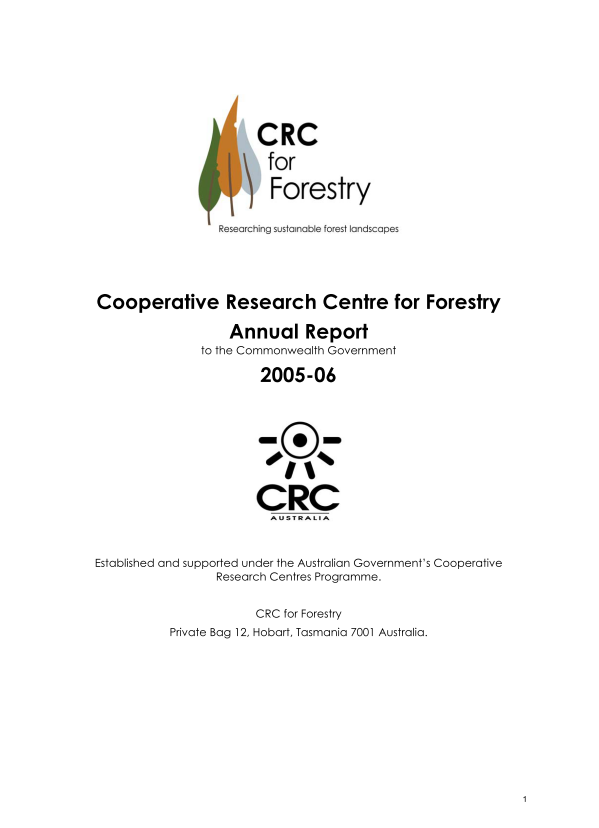 | 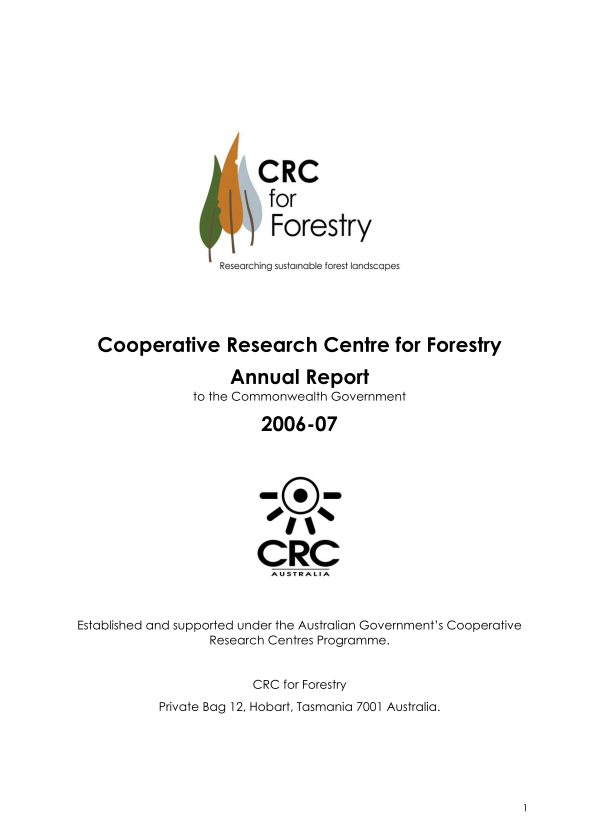 | 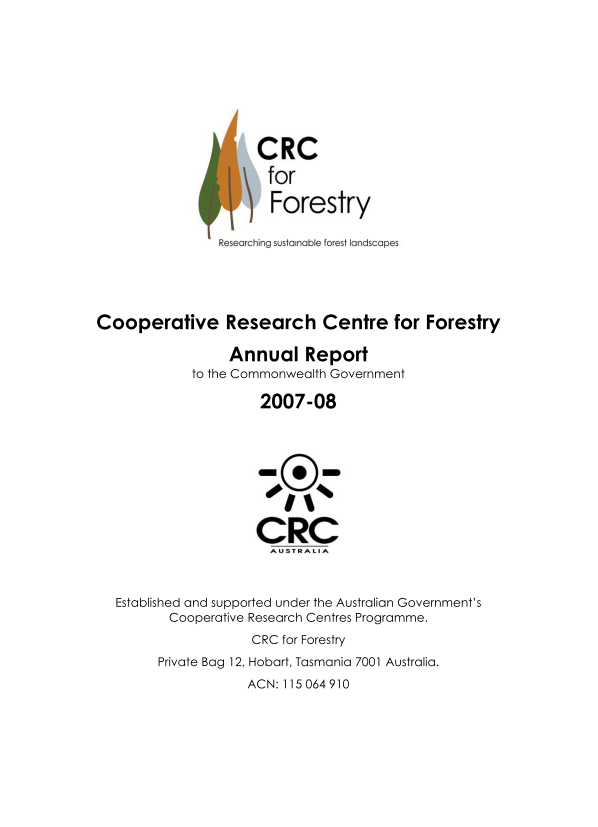 |
| 05/06 annual report (PDF, 631KB) | 06/07 annual report (PDF, 1,616KB) | 07/08 annual report (PDF, 871KB) |
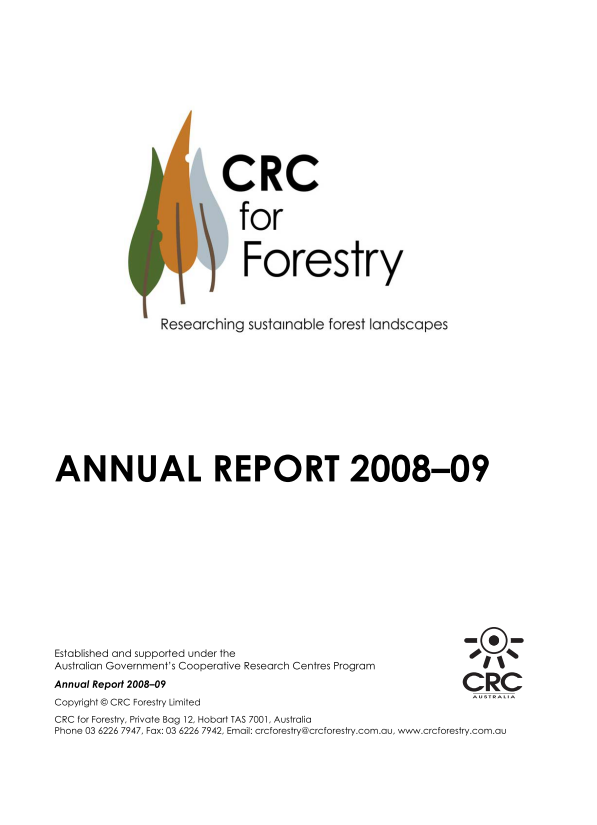 | 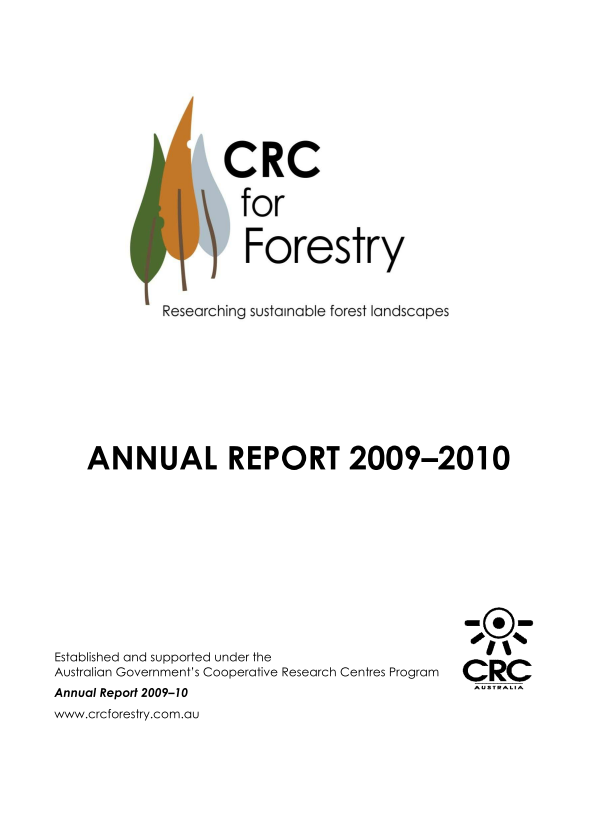 |  |
| 08/09 annual report (PDF, 7,415KB) | 09/10 annual report (PDF, 700KB) | 10/11 annual report (PDF, 393KB) |
CRC for Forestry Board Members
| Name and Position | |
|---|---|
 | Ms Kate Carnell Chair, CRC for Forestry |
 | Dr Lyndall Bull Board Member, CRC for Forestry |
 | Dr Hans Drielsma Board Member, CRC for Forestry |
 | Dr Gary Inions Board Member, CRC for Forestry |
 | Mr Bob Pearce Board Member, CRC for Forestry |
 | Professor Jim Reid Board Member, CRC for Forestry |
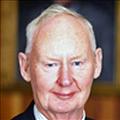 | Professor Geoff Wilson Board Member, CRC for Forestry |
 | Mr Rob Woolley Board Member, CRC for Forestry |
CRC for Forestry Partners
Core Partners
- CSIRO
- Department of Sustainability and Environment (VIC)
- Forest and Wood Products Australia Ltd
- Forestry Tasmania
- Forests and Forest Industry Council of Tasmania
- Gunns Ltd
- Hansol PI Pty Ltd
- Murdoch University
- Oji Paper Company Limited
- Southern Cross University
- University of Melbourne Forest Science
- University of Tasmania, School of Plant Science
- WA Plantation Resource Ltd
Supporting Partners
- Australian Forest Contractors Association
- Australian National University
- Department of Economic Development (TAS)
- Elders Forestry
- Forest Enterprises Australia Ltd
- Forest Practices Commission (WA)
- Forestry (SA)
- Hancock Victorian Plantations Pty Ltd
- Midway Limited
- NSW Department of Primary Industries
- Norske Skog Paper Mills (Australia) Ltd
- PIRSA Forestry
- Queensland Department of Agriculture, Fisheries and Forestry
- South East Fibre Exports (SEFE)
- Southern Tree Breeding Association
- Timberlands Pacific Pty Ltd
- University of the Sunshine Coast
- VicForests